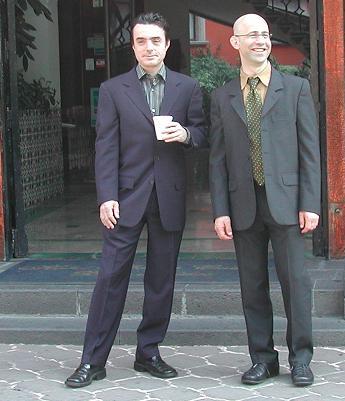
Just back from Mexico City, where I lectured on nostalgia (lecture title: “The Dismemberment of Things Past”) at the Museo Rufino Tamayo, as part of Cabinet magazine’s “Nostalgia” conference, and, later, solo at the Casa del Lago (lecture title: “Evil Empire,” a Baudrillardian critique of late-imperial America’s geopolitical arrogance and excess).
Thanks to the bush-beating efforts of Pacho, director of the Casa del Lago, and Francisco Caballo of the National University of Mexico (mil gracias, gentlemen), I racked up some press. The whip-smart cultural critic Fran Illich (of Borderhack! fame) introduced my Casa del Lago lecture, then blogged it. (Fran just sent a note–July 12–to say that he reviewed my Casa del Lago lecture for Modem Radio. If you habla espanol, check out the MP3 of Fran’s review, nestled in his 50-minute, techno-propelled program on digital culture.)
And a few media outlets interviewed me:
La Jornada (“Soy patologo cultural; la vida en EU esta enferma, afirma el critico Mark Dery”) and El Universal Online (here and here).There’s also a full-page write-up, embedded in this PDF, which makes mention of my forthcoming anthology of cultural criticism. (Search for my name, to find the article in question.) Published in Spanish only by the UNAM press, it will be titled Nitrato de amonio para el alma–”Ammonium Nitrate for the Soul.”
Both lectures went swimmingly, thanks to my gracious, ultra-competent hosts (Pacho, Francisco, and, at the Museum Tamayo, the extraordinary Pip Day). For me, the standout speakers at “Nostalgia” were co-panelist Daniel Rosenberg (whose forthcoming collection, Histories of the Future, sounds fascinating), Luc Sante (an inexhaustible fund of historical lore, gemlike insights, and weirder-than-fiction True Facts), and the scary-smart, deadpan-funny Sven-Olov Wallenstein. Happily, there’s a chance that Cabinet and the Museo will publish the papers presented in a bilingual anthology, sometime in the near future.
The true spotlight-stealer, though, was the city itself, a paradoxical, precolumbian mash-up of blood and poetry, raw sewage and French perfume, Dickensian misery and Gibsonian futurism–a mongrel metropolis straight out of Blade Runner (complete with techno-Aztec corporate citadels to rival that movie’s Tyrell pyramid).
The ancient Mexica‘s heliocentric cosmos has given way to the contemporary worship of ceaseless circulation, whether of liquid capital or cars. Mexicans are forever en route, orbiting the city in their cars or, more likely, immobilized in the Godard-ian traffic jams that are the city’s enduring contribution to installation art.
At the Museo Antropologia, I marveled at the precolumbian fashion fetish for cranial deformation through headbinding. Just as certain demographics in contemporary culture favor, say, Buns of Steel while others worship the steatopygous Butt, some of the precolumbian peoples preferred to bind infants’ skulls around the temples so that the crown of the head flared out, for a brachycephalic effect (think “lightbulb”); others bound the upper part of the skull to create a sloping forehead (think “conehead”). I once asked a neurologist, at a cocktail party, if cranial deformation produced not only a different-shaped brain but a different sort of mind, on the presumption that the artificially enlarged braincase would permit certain parts of the brain to expand to larger-than-normal proportions, while other areas of the brain would be constricted. He rattled the rocks in his glass nervously and edged toward the buffet, muttering only that the jury was out…
My only regret is that I wasn’t able to indulge in the Xtreme gastro-tourism I’d anticipated, from escamoles (black ant
larvae) to gusanos de maguey (butterfly larvae) to chupalines (fried grasshoppers). I’m convinced entomophagy is the culinary shape of things to come, the only sane solution to overpopulation, solid-waste crises, and increasingly extreme meteorological phenomena (brought to you by global warming). Insects are a high-protein, low-fat food source, far healthier for you than, say, beef. They’re also an excellent source of vitamins and minerals, such as phosphorus and iron–not to mention our last, best hope for avoiding the Soylent Green option. And there’s gazllions of the damn things: Beetles, for instance, make up the largest order in the animal kingdom; there are an estimated 350,000 named species of them, worldwide. “Crunch all you want; we’ll make more.”

magdalen
mark: if chupalines in all their chilified, deep-fried, tentacled glory is too much, one can always try the lil’ grasshopper guys chopped & sauteed. i had these in Oaxaca city: delish!
xo
magtif
M. Dery
Well, I would have tried either, but they were inevitably sold out, wherever I went. No tentacles on any grasshoppers I saw, though; yours sound like they missed the casting call for _Quatermass and the Pit: Six Million Years to Earth_.